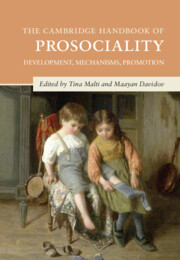Book contents
- The Cambridge Handbook of Prosociality
- Cambridge Handbooks in Psychology
- The Cambridge Handbook of Prosociality
- Copyright page
- Dedication
- Contents
- Figures
- Contributors
- Part I Development of Prosociality
- 1 Introduction: What Is Prosocial Development?
- 2 Developmental Theories of Prosociality
- 3 The Role of Genetics in the Development of Prosocial Behavior
- 4 Neurobiology of Prosociality
- 5 The Developmental Psychophysiology of Prosociality
- 6 The Origins of Prosociality from a Developmental and Comparative Perspective
- 7 Prosocial Behavior in Infancy and Early Childhood
- 8 Prosociality in Middle Childhood
- 9 Prosocial Behaviors in Adolescence
- 10 Prosocial Development across the Lifespan
- Part II Antecedents and Mechanisms of Prosociality
- Part III Development of Prosociality in Context
- Part IV Applications
- Index
- References
4 - Neurobiology of Prosociality
Investigating the Link between Empathy and Prosocial Behavior in the Brain
from Part I - Development of Prosociality
Published online by Cambridge University Press: 25 May 2023
- The Cambridge Handbook of Prosociality
- Cambridge Handbooks in Psychology
- The Cambridge Handbook of Prosociality
- Copyright page
- Dedication
- Contents
- Figures
- Contributors
- Part I Development of Prosociality
- 1 Introduction: What Is Prosocial Development?
- 2 Developmental Theories of Prosociality
- 3 The Role of Genetics in the Development of Prosocial Behavior
- 4 Neurobiology of Prosociality
- 5 The Developmental Psychophysiology of Prosociality
- 6 The Origins of Prosociality from a Developmental and Comparative Perspective
- 7 Prosocial Behavior in Infancy and Early Childhood
- 8 Prosociality in Middle Childhood
- 9 Prosocial Behaviors in Adolescence
- 10 Prosocial Development across the Lifespan
- Part II Antecedents and Mechanisms of Prosociality
- Part III Development of Prosociality in Context
- Part IV Applications
- Index
- References
Summary
A neurobiological perspective can inform us about the proximate mechanisms of prosocial behavior. Brain regions involved in empathic processing have been implicated in prosocial behaviors. However, prosocial behavior is dependent on regions beyond those involved in empathy. We outline recent meta-analyses that have converged on the finding that regions implicated in reward processing also play key roles in prosocial behaviors as do ventromedial and dorsolateral regions of the prefrontal cortex. We describe instances in which empathic processing is affected – in psychiatric conditions or following psychopharmacological interventions – and what consequences this can have for the neural correlates of prosocial behavior. We emphasize the need to have clear definitions of concepts like “empathy” and “prosocial behavior,” as these will ultimately inform the behavioral tasks used to measure the neural underpinnings of these phenomena. Finally, we discuss how advancements in neuroscientific techniques could further our understanding of the neurocognitive basis of prosocial behavior.
- Type
- Chapter
- Information
- The Cambridge Handbook of ProsocialityDevelopment, Mechanisms, Promotion, pp. 61 - 84Publisher: Cambridge University PressPrint publication year: 2023
References
- 2
- Cited by



